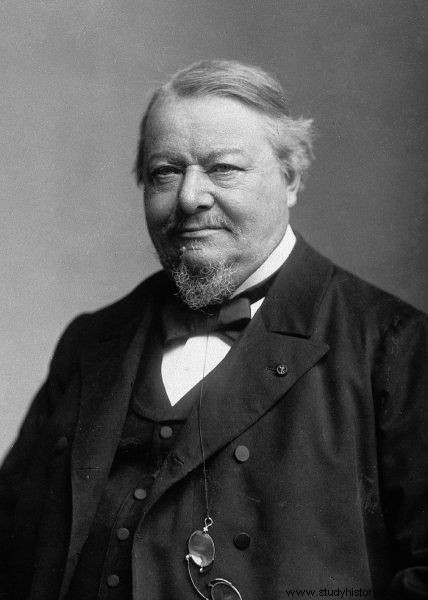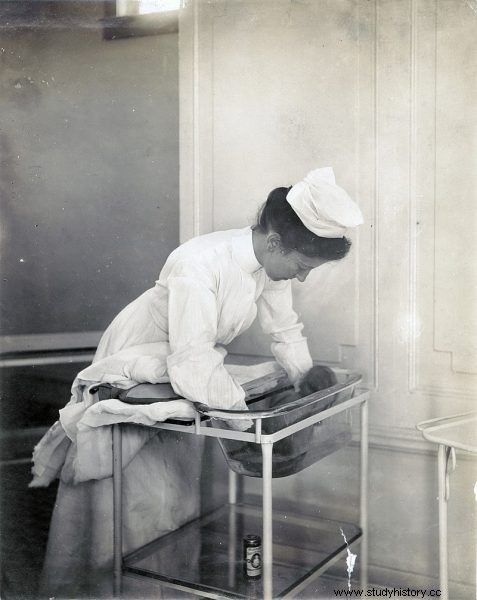The life of premature babies born before the 20th century was most often determined by fate - usually not very kind. A mysterious man and his "hatchery for children" came to the rescue of the little ones.
Doctors have long known that one of the main problems faced by immature bodies of premature babies is thermoregulation. Tiny babies simply don't have enough body fat to keep their body temperature at the right level. The first successful attempt to eliminate the problem was made in Paris, although a man called the Doctor Incubator is responsible for the spread of incubators in the world ...
Baby heater
Simple devices based on ... chicken hatching boxes! In 1880, the famous obstetrician and head of the Maternité hospital in Paris, Stephane Tarnier, visited the Jardin d'Acclimatation amusement park. It so happened that a model of a poultry incubator was shown, built on the basis of an ancient Egyptian design. In the pages of "History of Medicine" Mazurak and Czyżewska report:
Tarnier had the idea of putting a baby in the crate in place of a chicken egg. He asked Odile Martin, a poultry keeper in the Jardin des Plantes, to construct a children's incubator based on the chicken incubator design. He wanted to create a similar device with adequate ventilation and size to accommodate a human newborn. As a result, was created couveuse - a heated wooden box with two chambers, an opening at the bottom and a glass lid.

Originator of the first Stéphane Tarnier incubators.
The lower chamber was filled with water heated by an oil lamp, which in turn increased the air temperature in the part where the premature baby was located.
Despite the enormous simplicity of the invention, its implementation reduced the mortality rate of premature babies born to the world at the Maternité Hospital from 66% to 38%. Tarnier's successors in the fight for the lives of little people were Professor Pierre Budin and his assistant, Martin Couney. Budin wanted to spread the idea of isolating premature babies. To this end, he decided to… organize an exhibition in Berlin. He entrusted Couney with this task.
Secret assistant
The man who organized the groundbreaking, first in a long series of incubator shows, is shrouded in mystery and a hint of controversy. Previously his name was Michael Cohn. He was born in 1869 or 1870. To this day, we do not know where exactly - it could have been Alsace, Wrocław or Krotoszyn.
Apparently, he graduated from medical studies in Leipzig or Wrocław and in Berlin, although there is also uncertainty in this matter. He moved to Paris before 1890 and under the leadership of Pierre Boudin studied the mortality of premature babies ... but under a changed name :Parisians already knew him as Martin Couney.
As if all these secrets were not enough, according to some sources, the Doctor Incubator never graduated from medical studies! There is no mention of Couney or Cohn in the archives of the universities where he was to study. There are also no traces of his diploma thesis. Who was he then? We will have to answer this question in the words of Mincius Felix: Actus hominis, non dignitas iudicentur - "Let the deeds of man be judged, not his dignity."
The issues of Couney's background and education seem irrelevant to his achievements. Among other things, it was thanks to him that the mortality of premature babies significantly decreased, and incubators were permanently installed in hospitals.
Find out more:Midwives vs surgeons, or the war for the delivery room
Doctor Incubator steps into action
The show in the German capital turned out to be a huge success. It took place in 1896 at the Berlin Exposition, and the exhibition featured the latest models equipped with convection heating systems. There were six incubators in the pavilion, and in them - six premature babies. Of course, there was a risk:the children could die at any moment ... but fortunately the devices were working fine.
The exhibition was called Kinderbrutanstalt, or "hatchery for children". Thanks to the media advertising the opening of the exhibition with comedy songs and radio skits, the incubators were watched by a real crowd on the very first day. Each visitor paid one mark. After the "attraction" was closed, Martin Couney was named Doctor Incubator.

A nurse bathes a child during one of Doctor Incubator's exhibitions.
Another demonstration took place in London, though Couney had serious problems convincing conservative British doctors to 'borrow' premature babies. So he went to Paris, where he received - as it was later reported in The New York Times - "three wicker baskets full of Parisian premature babies." He returned with them to Great Britain and prepared a complete exhibition. From that moment on, he decided to take care of the shows professionally.
In 1898, the Doctor Incubator emigrated to the USA. Over the next half century, he opened exhibitions all over the continent. However, he was not warmly welcomed on Coney Island. The scientific community accused him of using defenseless babies for profit. “All my life I spread the knowledge of proper care for premature babies who were previously allowed to die. Everything I do is completely ethical, ”he defended himself.
The numbers support his argument:it is estimated that by 1952 he had saved the lives of 8,000 newborns - more than any hospital at that time! To give the children the best possible care, he employed nurses to feed them with their milk. The proceeds from admission tickets (25 cents per person) were used to cover operating expenses and pay for employees. He did not charge any fees from parents who agreed to place their child in the incubator.
He was so devoted to his work that the mischievous joked that the hump on Couney's back was the result of ... bending over the cribs of "his" newborns.
The fate of incubators
How did the history of neonatology develop? Midwife Anne Jorgensen describes:
Pioneering hospitals for premature babies were launched in the early 1900s at fairs, amusement parks and exhibitions. In 1896, Martin Couney, a student of the Paris doctors Stéphane Tarnier and Pièrre-Constant Budin, creators of the incubator, brought these devices to the United States.
Couney, known as the Doctor Incubator, was the first person to offer professional care to premature babies in the US . In 1901, Couney organized his first incubator exhibition at the Trans-Mississippi Exposition in Omaha, Nebraska.
The longest-lasting exhibition at Coney Island, called the Luna Park Incubator Exhibition. Visitors could see a long row of incubators in which little ones were lying, under the care of a team of doctors and nurses.
In 1930, the head of the pediatric department of Reese Hospital in Chicago, Julius Hess, developed an improved incubator with the ability to supply oxygen to the newborn. The machine could also be used in specially adapted ambulances.
Ten years later, an almost modern version of the device with plastic, transparent walls was put into use. Being able to see the baby closely inside proved to be a great step forward. "Naked babies were better examined, watched more closely and treated more effectively than ever." - reports Jorgensen. Today, neonatologists are breaking new boundaries, saving ever younger children. Work is also underway to create ... an artificial uterus in which the fetus could mature from fertilization to delivery. For now, however, it's still a song of the future.
Bibliography:
- Jorgensen, A. M., Born in the USA - The History of Neonatology in the United States:A Century of Caring . NICU Currents, 2010.
- Mazurak, M., Czyżewska, M., Incubator Doctor and the Dionne Quintuplets:on the Phenomenon of Exhibiting Premature Infants . Department of Neonatology, Silesian Piasts University of Medicine in Wrocław, 2006.
- Prentice, C., The Man Who Ran a Carnival Attraction That Saved Thousands of Premature Babies Wasn't a Doctor at All . Smithsonian Magazine (accessed October 9, 2020).
